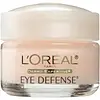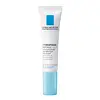What's inside
What's inside
 Key Ingredients
Key Ingredients

 Benefits
Benefits

 Concerns
Concerns

 Ingredients Side-by-side
Ingredients Side-by-side

Water
Skin ConditioningGlycerin
HumectantSimmondsia Chinensis Seed Oil
EmollientPropanediol
SolventPentaerythrityl Tetraethylhexanoate
EmollientPolyglyceryl-2 Stearate
EmulsifyingPhenoxyethanol
PreservativeCarbomer
Emulsion StabilisingCaffeine
Skin ConditioningMyristyl Alcohol
EmollientBisabolol
MaskingMethylparaben
PreservativeSodium Hydroxide
BufferingXanthan Gum
EmulsifyingMica
Cosmetic ColorantEthylparaben
PreservativeDisodium EDTA
Avena Sativa Kernel Extract
AbrasiveCitric Acid
BufferingCI 77891
Cosmetic ColorantFarnesol
PerfumingSodium Hyaluronate
HumectantCI 16035
Cosmetic ColorantWater, Glycerin, Simmondsia Chinensis Seed Oil, Propanediol, Pentaerythrityl Tetraethylhexanoate, Polyglyceryl-2 Stearate, Phenoxyethanol, Carbomer, Caffeine, Myristyl Alcohol, Bisabolol, Methylparaben, Sodium Hydroxide, Xanthan Gum, Mica, Ethylparaben, Disodium EDTA, Avena Sativa Kernel Extract, Citric Acid, CI 77891, Farnesol, Sodium Hyaluronate, CI 16035
Water
Skin ConditioningGlycerin
HumectantCarbomer
Emulsion StabilisingGlycine Soja Protein
EmulsifyingCaffeine
Skin ConditioningIsohexadecane
EmollientSodium Cocoyl Glutamate
CleansingSodium Hyaluronate
HumectantSodium Hydroxide
BufferingDisodium EDTA
Hydrolyzed Hyaluronic Acid
HumectantCaprylyl Glycol
EmollientPolysorbate 80
EmulsifyingAcrylamide/Sodium Acryloyldimethyltaurate Copolymer
Emulsion StabilisingPotassium Sorbate
PreservativeSodium Benzoate
MaskingWater, Glycerin, Carbomer, Glycine Soja Protein, Caffeine, Isohexadecane, Sodium Cocoyl Glutamate, Sodium Hyaluronate, Sodium Hydroxide, Disodium EDTA, Hydrolyzed Hyaluronic Acid, Caprylyl Glycol, Polysorbate 80, Acrylamide/Sodium Acryloyldimethyltaurate Copolymer, Potassium Sorbate, Sodium Benzoate
Ingredients Explained
These ingredients are found in both products.
Ingredients higher up in an ingredient list are typically present in a larger amount.
Caffeine is most associated with coffee, tea, and cacao. In skincare, it helps with calming inflammation and is rich in antioxidants.
While caffeine is used to treat cellulite and and dark circles, further studies are needed to prove this. It has been believed to help with these skin conditions due to its ability to dilate blood vessels and increase blood flow.
Some studies are looking into caffeine's ability to protect against UV rays.
Learn more about CaffeineCarbomer is a polymer of acrylic acid. Its main role is to create a gel consistency.
A high amount of carbomer can cause pilling or balling up of products. Don't worry, most products contain 1% or less of carbomer.
Disodium EDTA plays a role in making products more stable by aiding other preservatives.
It is a chelating agent, meaning it neutralizes metal ions that may be found in a product.
Disodium EDTA is a salt of edetic acid and is found to be safe in cosmetic ingredients.
Learn more about Disodium EDTAGlycerin is already naturally found in your skin. It helps moisturize and protect your skin.
A study from 2016 found glycerin to be more effective as a humectant than AHAs and hyaluronic acid.
As a humectant, it helps the skin stay hydrated by pulling moisture to your skin. The low molecular weight of glycerin allows it to pull moisture into the deeper layers of your skin.
Hydrated skin improves your skin barrier; Your skin barrier helps protect against irritants and bacteria.
Glycerin has also been found to have antimicrobial and antiviral properties. Due to these properties, glycerin is often used in wound and burn treatments.
In cosmetics, glycerin is usually derived from plants such as soybean or palm. However, it can also be sourced from animals, such as tallow or animal fat.
This ingredient is organic, colorless, odorless, and non-toxic.
Glycerin is the name for this ingredient in American English. British English uses Glycerol/Glycerine.
Learn more about GlycerinSodium Hyaluronate is hyaluronic acid's salt form. It is commonly derived from the sodium salt of hyaluronic acid.
Like hyaluronic acid, it is great at holding water and acts as a humectant. This makes it a great skin hydrating ingredient.
Sodium Hyaluronate is naturally occurring in our bodies and is mostly found in eye fluid and joints.
These are some other common types of Hyaluronic Acid:
Learn more about Sodium HyaluronateSodium Hydroxide is also known as lye or caustic soda. It is used to adjust the pH of products; many ingredients require a specific pH to be effective.
In small amounts, sodium hydroxide is considered safe to use. However, large amounts may cause chemical burns due to its high alkaline.
Your skin has a natural pH and acid mantle. This acid mantle helps prevent harmful bacteria from breaking through. The acid mantle also helps keep your skin hydrated.
"Alkaline" refers to a high pH level. A low pH level would be considered acidic.
Learn more about Sodium HydroxideWater. It's the most common cosmetic ingredient of all. You'll usually see it at the top of ingredient lists, meaning that it makes up the largest part of the product.
So why is it so popular? Water most often acts as a solvent - this means that it helps dissolve other ingredients into the formulation.
You'll also recognize water as that liquid we all need to stay alive. If you see this, drink a glass of water. Stay hydrated!
Learn more about Water